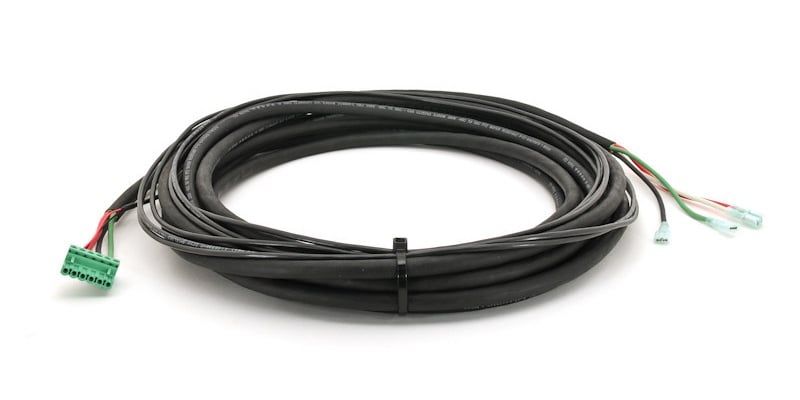There are many areas to consider when designing and building cost-effective custom cable assemblies. The areas of primarily importance to be reviewed are the raw material selection, ensuring your assembly is designed for ease of manufacturability, choosing the correct connector, and correctly specifying the criteria the assembly should meet or exceed. If all of these areas are optimized correctly in the design stage, you stand the best chance of keeping your manufacturing costs as low as possible.
Cable Assembly Raw Materials
Raw materials account for a large percentage of a cable assembly’s costs. Matching the conductor, insulation, and shielding with the environment that the assembly will be used in will provide for a cost-effective cable assembly. Using conductors with a higher stranding than is needed or with plating that is not warranted by the application will result in an assembly with unnecessary added costs. Matching the size of the conductor to the electrical requirements of the application from a voltage and ampacity needs standpoint will result in a more cost-effective assembly. The general rule is that higher strand conductors are associated with higher costs.

Choosing Cost Effective Cable Assemblies
Choosing compounds that will provide the proper level of performance needed for the installation is the most effective way to manage cable assembly cost. Various compounds are available that could provide broad ranges of both temperature and voltage ratings. Using a compound that offers a higher temperature rating or a high voltage rating than the installation requires, again, unnecessarily drives the costs higher and makes for an ineffective cable assembly. As the temperature rating of a compound increases, so does the cost, which ultimately produces an assembly with characteristics that far exceed what is needed for the installation.>
Matching the shielding of a cable assembly to the type of signal that the assembly will transmit is an important consideration when achieving the lowest costs for your assembly. Shields are available in different configurations ranging from single sided tapes with a metallic skin adhered to a base material like polyester up to braids consisting of metal strands woven around the cable core. The purpose of tapes is to offer EMI/RFI protection to either the components within the cable or the cable itself. A custom cable assembly design with more shielding than necessary or the wrong type of shielding can result in added costs.
Cable Assembly Design for Ease of Manufacturability
When designing a custom cable assembly, the desire to specify extremely tight tolerances should be avoided whenever possible. There are applications where a tight tolerance is required - such as when very specific electrical characteristics are needed or when the assembly is to be routed through a predetermined opening. In these instances, a tight tolerance is needed to ensure the assembly meets the application. In some applications, adherence to published standards is acceptable, such as IPC/WHMA-A-620. The dimensions referred to in a document such as this provide for manufacturing that is most efficient and offer the most cost-effective assembly possible.
Create the Simplest Design That Meets Your Needs
There is a tendency to over-design cable assemblies. The designer should choose a color code for the primary insulation that aids in termination of the cable by choosing contrasting colors and avoiding light and dark shades of the same color (i.e. light blue, blue, dark blue). Having distinct and contrasting colors makes the termination process more efficient and cost effective.
The components in the assembly should be matched to the expected usable life of the equipment the assembly will be used on. If the equipment is expected to have a life-expectancy of 10 years, you shouldn’t design a cable assembly that is built to last 30–40 years. Adding the components needed for the additional life of the assembly will once again raise your costs.
Choose the Right Connectors
The connectors chosen for any given application need to match the form, fit, and function of the expected performance of the finished cable assembly. The designer, if possible, should allow the use of substitute connectors. In most instances, the substitutes will perform as well as the original connector. If possible, the designer should avoid getting into a situation where the connectors chosen are only produced by one manufacturer. Finding more universal connectors helps to avoid supply and pricing issues that can drive up costs for cable assemblies.
Don’t Overcomplicate
If the assembly will be installed in a stationary application, there is not a need to design in a flexible cable assembly. To achieve flexibility, the assembly producer will build the cable with high strand count conductors and use compounds developed for continuous motion, both of which will drive up costs.
Summary
Designing and building a cost-effective cable assembly requires understanding of the specific needs of your application and matching the assembly properties to those needs. Over-designing custom cable assemblies produces wasted capacity and results in an assembly that is not cost effective.
Key Takeaways
- Optimize Raw Material Selection: Choose conductors, insulation, and shielding that match the application’s electrical and environmental requirements to avoid unnecessary material costs.
- Avoid Overengineering: Using higher-rated temperature or voltage materials, excessive shielding, or tight tolerances beyond what the application needs drives up costs without improving performance.
- Design for Manufacturability: Following established standards like IPC/WHMA-A-620 and using practical tolerances ensures efficient, cost-effective production.
- Select Connectors Wisely: Use interchangeable, widely available connectors rather than proprietary options to reduce sourcing risks and maintain price stability.
- Match Design Complexity to Application Needs: Keep assemblies as simple as possible. Avoid adding flexibility or longevity that exceeds the intended use, which leads to wasted cost and overbuilt products.
















